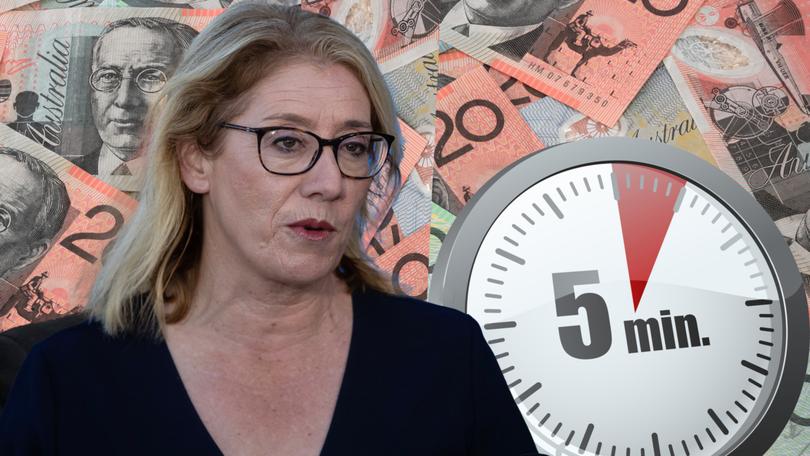WA State Budget 2024: A five-minute guide on what it means for you

Rita Saffioti has handed down her first Budget since becoming Treasurer last year. The financial statement, Labor’s eighth, showed Western Australia was the envy of the nation and going from strength to strength, with a big spend on infrastructure.
Here’s what you need to know:
FINANCES
Sign up to The Nightly's newsletters.
Get the first look at the digital newspaper, curated daily stories and breaking headlines delivered to your inbox.
By continuing you agree to our Terms and Privacy Policy.WA is set to book a $3.2 billion surplus this financial year, a drop from the $3.7 billion predicted in the mid-year review after additional Federal funding for Metronet was not banked. Over the next four years, the Government banks $10 billion in surpluses, of between $2.4 billion and $2.8 billion — including $2.6 billion in the 2024-25 financial year.
“We’ve seen some volatility in our revenue base, in particular commodity prices and that’s primarily driven by changes in cashflows from the Commonwealth for some of the payments,” she said.
Net debt is on track to climb from $28.6 billion by June 30, to more than $40 billion by 2027-28, which the Ms Saffioti described as still significantly lower than any other jurisdiction.
HOUSEHOLD FEES AND CHARGES
The centrepiece for households from Saffioti’s first Budget is another $400 power bill credit, the fourth offered to consumers. Since the first discount was offered in the midst of the pandemic, West Aussies have had $1400 shaved off utility bills.
The credit, to be automatically applied to 1.1 million households in two parts - first in July or August, and second in December or January, in line with peak power usage.
Further savings come from the Government’s announcement of free public transport for students, saving families a further $280 per child a year, with the government claiming household costs have dropped by 2 per cent.
But hidden in the figures is a 2.5 per cent the price of power and water from July, and a 5 per cent increase in the emergency services levy, due to the increase threat of bushfires and natural disasters.
All up the Government is spending $762 million on relief for households - including the Student Assistance Payment.
IRON ORE
The State’s main economic driver, iron ore, delivered $11.2 billion in royalties to Treasury’s books this financial year, with those lower price forecasts meaning it is expected to bring in almost $6 billion in 2023-24.
But the State’s reliance on the commodity is set to plummet, with royalty returns forecast to drop by $3.5 billion as the price lowers to $US75 per tonne in 2024-25.
Amid the a volatile global market, Ms Saffioti lifted the long-run average for the iron ore price to $US71 per tonne, up from a long-standing $US66 figure.
“From the start of the Budget process to the end, there was a 36 per cent decline in the iron ore price - those assumptions moving around are very tricky,” Ms Saffioti said.
The lift, which the Treasurer said was still conservative, was more in line with expectations, following a similar change in the Federal Government’s estimate.
The commodity is still the biggest single source of income for WA, accounting for almost 80 per cent of total royalty income on average from 2024-25 onwards.
WAGES
Households will see easing pressure off the back of strong wage growth of 4.25 per cent this financial year, before slowly dropping to 3.75 per cent on 2024-25 and then down again to 3 per cent in 2027-28.
The Budget papers explained that wages would slow alongside a modest easing in the labour market and a closer focus from businesses on costs.
Inflation, meanwhile, is predicted to drop to 3 per cent after June, and stabilise at 2.5 per cent for the next three year, returning within the Reserve Bank of Australia’s target band.
THE NEW SPENDS
METRONET
Ms Saffioti’s own flagship project of Metronet was a key focus in this Budget, with a combined State and Federal funding boost of $700 million, with a $4.8 billion spend over the next four years, taking the transport project’s total cost to more than $12 billion.
That cost comes as the project’s key pillars are set to be opened, with the Yanchep extension already booked into run from July, Ellenbrook services before the end of this year, and other lines before next July.
STAMP DUTY
Ms Saffioti announced $82 million to raise the stamp duty exemption threshold for first home buyers to $450,000, and $600,000 for concession holders.
HEALTH
An additional $3.2 billion boost for health services will seek to recruit more doctors and nurses, and roll out the Electronic Medical Record program.
OPERATING SURPLUS
NET DEBT
UNEMPLOYMENT RATE
WAGES GROWTH
IRON ORE PRICE ($US/TONNE)
GOVERNMENT EXPENSES 2024-25
NET CONTRIBUTION OF EACH STATE TO THE FEDERATION PER CAPITA
